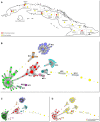Microsatellite typing of clinical and environmental Cryptococcus neoformans var. grubii isolates from Cuba shows multiple genetic lineages
- PMID: 20161737
- PMCID: PMC2817729
- DOI: 10.1371/journal.pone.0009124
Microsatellite typing of clinical and environmental Cryptococcus neoformans var. grubii isolates from Cuba shows multiple genetic lineages
Abstract
Background: Human cryptococcal infections have been associated with bird droppings as a likely source of infection. Studies toward the local and global epidemiology of Cryptococcus spp. have been hampered by the lack of rapid, discriminatory, and exchangeable molecular typing methods.
Methodology/principal findings: We selected nine microsatellite markers for high-resolution fingerprinting from the genome of C. neoformans var. grubii. This panel of markers was applied to a collection of clinical (n = 122) and environmental (n = 68; from pigeon guano) C. neoformans var. grubii isolates from Cuba. All markers proved to be polymorphic. The average number of alleles per marker was 9 (range 5-51). A total of 104 genotypes could be distinguished. The discriminatory power of this panel of markers was 0.993. Multiple clusters of related genotypes could be discriminated that differed in only one or two microsatellite markers. These clusters were assigned as microsatellite complexes. The majority of environmental isolates (>70%) fell into 1 microsatellite complex containing only few clinical isolates (49 environmental versus 2 clinical). Clinical isolates were segregated over multiple microsatellite complexes.
Conclusions/significance: A large genotypic variation exists in C. neoformans var. grubii. The genotypic segregation between clinical and environmental isolates from pigeon guano suggests additional source(s) of human cryptococcal infections. The selected panel of microsatellite markers is an excellent tool to study the epidemiology of C. neoformans var. grubii.
Conflict of interest statement
Figures

Similar articles
-
Multilocus microsatellite typing for Cryptococcus neoformans var. grubii.Med Mycol. 2008 Nov;46(7):685-96. doi: 10.1080/13693780802027062. Med Mycol. 2008. PMID: 18608927
-
Genotypic diversity in clinical and environmental isolates of Cryptococcus neoformans from India using multilocus microsatellite and multilocus sequence typing.Mycoses. 2020 Mar;63(3):284-293. doi: 10.1111/myc.13041. Epub 2020 Jan 13. Mycoses. 2020. PMID: 31820495
-
Molecular epidemiology of Italian clinical Cryptococcus neoformans var. grubii isolates.Med Mycol. 2013 Jul;51(5):499-506. doi: 10.3109/13693786.2012.751642. Epub 2013 Jan 4. Med Mycol. 2013. PMID: 23286351
-
Molecular typing of clinical Cryptococcus neoformans isolates collected in Germany from 2004 to 2010.Med Microbiol Immunol. 2014 Oct;203(5):333-40. doi: 10.1007/s00430-014-0341-6. Epub 2014 May 17. Med Microbiol Immunol. 2014. PMID: 24838744
-
Epidemiology of Cryptococcus and cryptococcosis in China.Fungal Genet Biol. 2015 May;78:7-15. doi: 10.1016/j.fgb.2014.10.017. Epub 2014 Nov 7. Fungal Genet Biol. 2015. PMID: 25445309 Review.
Cited by
-
A Short-Tandem-Repeat Assay (MmySTR) for Studying Genetic Variation in Madurella mycetomatis.J Clin Microbiol. 2021 Feb 18;59(3):e02331-20. doi: 10.1128/JCM.02331-20. Print 2021 Feb 18. J Clin Microbiol. 2021. PMID: 33298608 Free PMC article.
-
Resistance of Asian Cryptococcus neoformans serotype A is confined to few microsatellite genotypes.PLoS One. 2012;7(3):e32868. doi: 10.1371/journal.pone.0032868. Epub 2012 Mar 13. PLoS One. 2012. PMID: 22427900 Free PMC article.
-
Donor transmission of Cryptococcus neoformans presenting late after renal transplantation.Clin Kidney J. 2013 Apr;6(2):224-7. doi: 10.1093/ckj/sft006. Clin Kidney J. 2013. PMID: 26019853 Free PMC article. No abstract available.
-
New Short Tandem Repeat-Based Molecular Typing Method for Pneumocystis jirovecii Reveals Intrahospital Transmission between Patients from Different Wards.PLoS One. 2015 May 1;10(5):e0125763. doi: 10.1371/journal.pone.0125763. eCollection 2015. PLoS One. 2015. PMID: 25933203 Free PMC article.
-
Molecular Epidemiology of Clinical Cryptococcus neoformans Isolates in Seoul, Korea.Mycobiology. 2014 Mar;42(1):73-8. doi: 10.5941/MYCO.2014.42.1.73. Epub 2014 Mar 31. Mycobiology. 2014. PMID: 24808738 Free PMC article.
References
-
- Bicanic T, Harrison TS. Cryptococcal Meningitis. Br Med Bull. 2004;72:99–118. - PubMed
-
- Park BJ, Wannemuehler KA, Marston BJ, Govender N, Pappas PG, et al. Estimation Of The Current Global Burden Of Cryptococcal Meningitis Among Persons Living With HIV/AIDS. AIDS. 2009;23:525–530. - PubMed
-
- Levitz SM, Boekhout T. Cryptococcus: The Once-Sleeping Giant Is Fully Awake. FEMS Yeast Res. 2006;6:461–462. - PubMed
-
- Bovers M, Hagen F, Boekhout T. Diversity Of The Cryptococcus Neoformans-Cryptococcus Gattii Species Complex. Rev Iberoam Micol. 2008;25:S4–12. - PubMed
-
- Bovers M, Hagen F, Kuramae EE, Boekhout T. Six Monophyletic Lineages Identified Within Cryptococcus Neoformans And Cryptococcus Gattii By Multi-Locus Sequence Typing. Fungal Genet Biol. 2008;45:400–421. - PubMed
Publication types
MeSH terms
Substances
LinkOut - more resources
Full Text Sources
Miscellaneous

